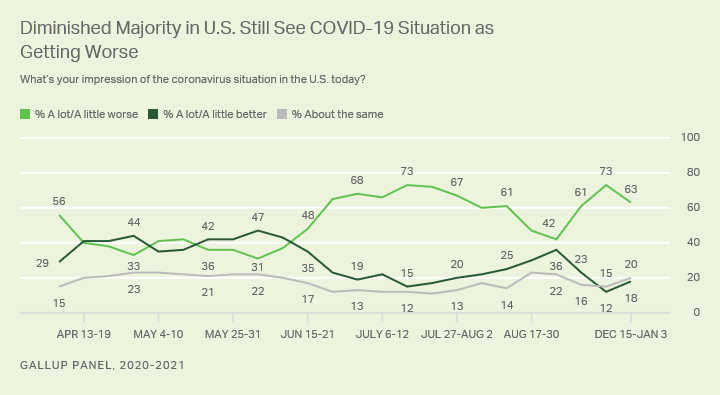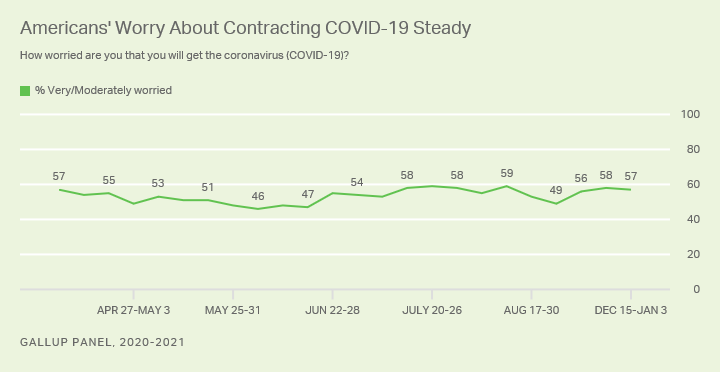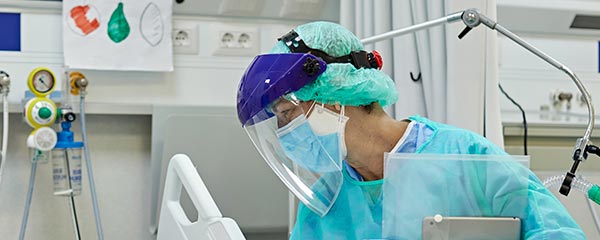Story Highlights
- 63% now say the situation is getting worse, down from 73%
- Assessments have been worse in months with larger growth in cases
- 57% are worried about getting COVID-19, similar to recent months
WASHINGTON, D.C. -- Gallup's late December/early January update on COVID-19 attitudes finds a modest reduction in the percentage of Americans who say the situation is "getting worse." Sixty-three percent of U.S. adults now hold this view, down from 73% in late November. Twenty percent currently think the situation is "staying about the same" and 18% say it is "getting better." These figures are up five and six percentage points, respectively.

Line graph. Sixty-three percent of U.S. adults say the COVID-19 situation in the U.S. is getting worse, down from 73% in late November, but still ranking among the highest measured in Gallup's trend. Before June, the percentage saying the situation was getting worse was usually under 50%.
The latest data come from a Dec. 15-Jan. 3 web survey of more than 3,000 U.S. adults who are members of Gallup's probability-based panel. Since that survey was conducted, the U.S. has experienced some of its deadliest single days during the pandemic.
Since late June, majorities of Americans have said the situation is getting worse, with the exceptions of a 47% reading in late August and a 42% reading in late September.
Assessments of the coronavirus situation show a meaningful relationship with the trend in coronavirus cases in the U.S. In months with larger percentage increases in COVID-19 cases from the prior month, there has typically been an increase in the percentage of Americans saying the situation is getting worse. When the percentage increase in cases from the prior month has been more modest -- such as in December -- or has declined, fewer Americans than in the previous month have said the situation is getting worse.

Line graph. When changes in the percentage of COVID-19 cases from the prior month are plotted alongside the percentage of Americans saying the COVID-19 situation is getting worse in the U.S., the two lines generally track one another. Months seeing a higher percentage increase in cases from the prior month are usually met with an increase in the percentage saying the situation is getting worse, most notably in July and November. When the percentage increase in cases has been relatively low or there has been a decline, such as in August and December, there has been a decrease in the percentage saying the situation is getting worse.
The major exception to that pattern is for April, which showed 42% saying the situation was getting worse despite a nearly 300% increase in cases from March -- largely because there were many fewer cases in March than in subsequent months. In March, cases were more isolated geographically than they are now.
In the summer months, states in the Sun Belt region experienced a surge in cases. By November and December, case counts exploded across the country.
Even though December saw the most COVID-19 cases of any month to date, the increase in cases from the elevated number of November cases was relatively modest compared with increases seen in April, July and November from the prior months. Thus, the December increase may have seemed less dramatic to Americans than the larger percentage increases from June to July and October to November.
Fewer in All Party Groups Say Situation Getting Worse
Democrats, independents and Republicans are all less inclined now than in late November to perceive the situation as getting worse, with decreases ranging between eight and 12 percentage points.
Still, wide partisan gaps remain, with more than eight in 10 Democrats believing the situation is worsening, compared with fewer than four in 10 Republicans.
| Republicans | Independents | Democrats | |||||||||||||||||||||||||||||||||||||||||||||||||||||||||||||||||||||||||||||||||||||||||||||||||
|---|---|---|---|---|---|---|---|---|---|---|---|---|---|---|---|---|---|---|---|---|---|---|---|---|---|---|---|---|---|---|---|---|---|---|---|---|---|---|---|---|---|---|---|---|---|---|---|---|---|---|---|---|---|---|---|---|---|---|---|---|---|---|---|---|---|---|---|---|---|---|---|---|---|---|---|---|---|---|---|---|---|---|---|---|---|---|---|---|---|---|---|---|---|---|---|---|---|---|---|
| Nov | Dec-Jan | Nov | Dec-Jan | Nov | Dec-Jan | ||||||||||||||||||||||||||||||||||||||||||||||||||||||||||||||||||||||||||||||||||||||||||||||
| % Getting better | 26 | 31 | 13 | 17 | 2 | 10 | |||||||||||||||||||||||||||||||||||||||||||||||||||||||||||||||||||||||||||||||||||||||||||||
| % Staying the same | 29 | 32 | 16 | 25 | 4 | 8 | |||||||||||||||||||||||||||||||||||||||||||||||||||||||||||||||||||||||||||||||||||||||||||||
| % Getting worse | 46 | 38 | 71 | 59 | 95 | 83 | |||||||||||||||||||||||||||||||||||||||||||||||||||||||||||||||||||||||||||||||||||||||||||||
| Gallup Panel, 2020-2021 | |||||||||||||||||||||||||||||||||||||||||||||||||||||||||||||||||||||||||||||||||||||||||||||||||||
Worry About Getting COVID-19 Holding Steady
Fifty-seven percent of Americans say they are very (15%) or somewhat (42%) worried about getting the coronavirus, similar to most readings since July. The 49% who were worried in late September is the main exception. Since the summer, concern about being infected with the coronavirus has been slightly higher than it was in May and June, when it averaged 50%.

Line graph. Fifty-seven percent of Americans are worried about getting the coronavirus, similar to what it has been for much of the time since June.
Partisanship remains a significant predictor of COVID-19 concern. Whereas 79% of Democrats and 57% of independents are worried, just 31% of Republicans are.
There are also wide gaps in worry by education (70% of college graduates versus 52% of college nongraduates) and gender (64% of women and 52% of men).
Bottom Line
Americans remain pessimistic about the coronavirus situation, as has been the case since June. The U.S. is on pace in January to have the highest number of cases and deaths so far, and Americans' assessments of the situation are likely to remain gloomy.
Although the development of multiple vaccines offers hope, the continuing surge in cases and deaths since November, and the arrival of potentially more contagious mutations of the virus, make it clear the nation is still not close to putting the pandemic behind it. The slower-than-hoped rollout of vaccinations to priority populations may prolong the situation, especially if it leads to delays in vaccinating the general public.
Learn more about how the Gallup Panel works.



